Tales from the Front Lines of a Restaurant Start-up
Carroll Gardens newbie Sheila’s is banking on becoming a neighborhood mainstay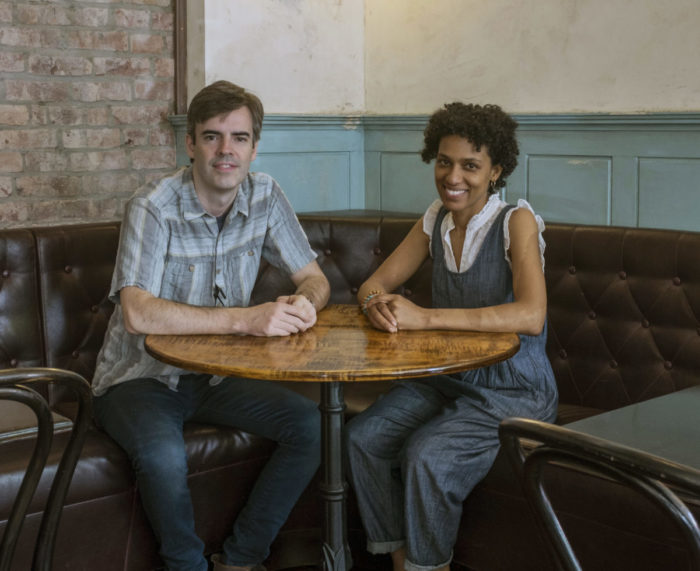
Colin Clarke and Molly Carlot-Clarke at their favorite table in their restaurant Sheila's (Photo by Harry Koepp)
Don’t be fooled by the gleaming pastry case or the casual vibe.
Opening a restaurant, especially in saturated Brooklyn, involves precise clockwork. In fact, it’s just like launching a start-up, except instead of selling one product, you’re selling hundreds. Service, hours of operation, coffee temperature, barstools, wine selection–everything has to be right. And that’s only what the customers happen to see. So much goes on behind the scenes, even before the sun rises, that anyone who’s harbored a secret dream of opening their own restaurant might run away screaming.
Being original in that kind of environment is risky. Yet that’s exactly what Sheila’s in Carroll Gardens aspires to be—a start-up that cares about its employees, vision, and every neighborhood customer who walks in the door begging for a croissant for their commute or a glass of wine as a wind-down. It’s a mom-and-pop neighborhood joint, in the best way, at a time when that’s getting harder to find.
And yet, “I’m not a morning person,” says owner Colin Clarke, which is surprising, since he’s clocking 4:30 a.m. wake-ups to spend 20-hour days in his new, all-day farm-to-table restaurant. Clarke is a veteran of local favorite Franny’s, where he spent six years (the beloved Flatbush Avenue pizzeria closed Aug. 20; the neighborhood mourns), and Gramercy Tavern, where he clocked seven years and was indoctrinated into the Danny Meyer school of hospitality. You could say dinner service is in Clarke’s DNA.
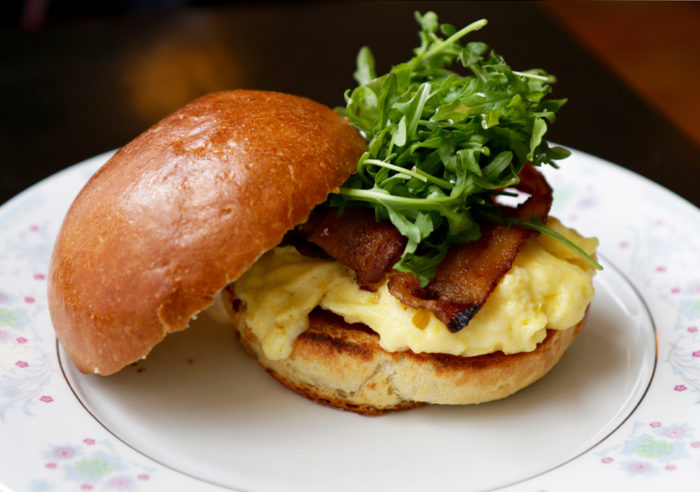
An inviting egg sandwich at Sheila’s (Photo courtesy of Sheila’s)
There’s a reason most restaurants don’t stay open from coffee through cocktails: it’s grueling. There’s no downtime to train staff, no moment to catch your breath, or plan for tomorrow. But there’s also more chances to provide new experiences–and they’re giving it a shot by merging old-school tactics with new-school models, and learning how to pivot along the way. They’re hosting special events and parties, soon launching a delivery menu through Caviar, and exploring after-dinner hours to make the space a hang-out for wine, drinks, and snacks. Here’s how Sheila’s started.
Start with a Spark
Almost three years ago, Clarke was walking around Battery Park with a friend who suggested that he and his wife Molly start their own restaurant. “Nah,” was his logical response. But later, in a car ride with Molly, the idea persisted and Colin couldn’t help but think, “Well, I wonder what it would be like, what’d be on the menu, what would I create?” He stayed up all night writing out the menu and the plan and then said … I gotta do it.
Keep Looking Until You Find the One
Once the seed was planted, Colin and Molly scoured available properties all over Brooklyn for two years, even checking out a rundown mosque. “We were looking for a space that kind of moved us in a neighborhood that resonated with us,” he says. They also wanted to avoid compromising their concept for a space with a wonky or awkward kitchen. After a few negotiations fell through, they found themselves at 412 Court St., the space that held Dover, the celebrated but pricey restaurant that closed in January. This was the one.
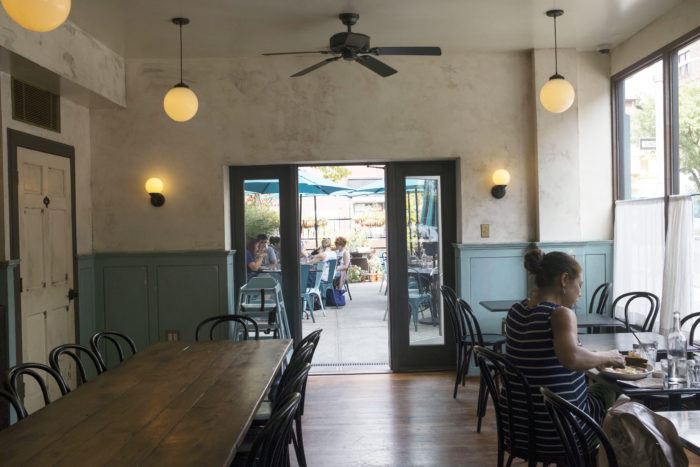
Sheila’s rustic interior opens up to a side courtyard (Photo by Harry Koepp)
Be Bold and Pivot
Sheila’s launched in June as a gratuity-free establishment, which meant tips were built into the menu prices and the restaurant paid everyone from servers to dishwashers to line cooks a higher wage on the back end. (Danny Meyer’s Union Square Hospitality Group is in the middle of transitioning all of its restaurants to a tipless “Hospitality Included” platform.) Clarke and a friend with a PhD in economics spent two years developing the system, incorporating a revenue-sharing model based on performance, with revenue going to both the front and back of house, so employees would still have incentive to perform well.
While the neighborhood reception was positive, Clarke was aware of the challenges of launching with this model, which is still somewhat unfamiliar to diners, and after a few early months, Sheila’s defaulted to a traditional tip-pool model. “To fully embrace the [tipless] model would have required us raising prices beyond what we felt comfortable with as a new all-day cafe/restaurant introducing ourselves to the neighborhood,” he says. When it comes to a cheeseburger, sticker shock is real.
Building the Culture
At a large restaurant, one bad egg won’t spoil the dozen, but in a streamlined operation, the culture is even more important. It was important to find reliable and passionate people to help the restaurant grow. It took time to build the staff for dinner service, but the right culture starts with a single person. “You’ve gotta get one person that you like and feel strongly about, whether it’s a line cook or dishwasher or server or purveyor, and that builds a culture,” says Clarke. Then, when a new person is hired, they sense there’s good people around and “it’s not a mishmash of personalities.”
But Watch Out for the Croissants
In the summer, humidity doesn’t only ruin a good hair day; it can really kill a croissant. The original plan was to make all the pastries in-house, but the space downstairs proved to be too fickle for laminated dough. Air conditioning the room was cost-prohibitive, so they called up Balthazar, and the SoHo spot is now supplying the pastries. Unforeseen challenges are inevitable. Deciding about the menu or aesthetics is easy, says Clarke, but “all sorts of things happen on a daily basis which feel like, whether it’s true or not, it threatens your vision, the path, and the progress.” Pangs of doubt intrude. “You feel every moment when one of those things happens that it’s not gonna work.”
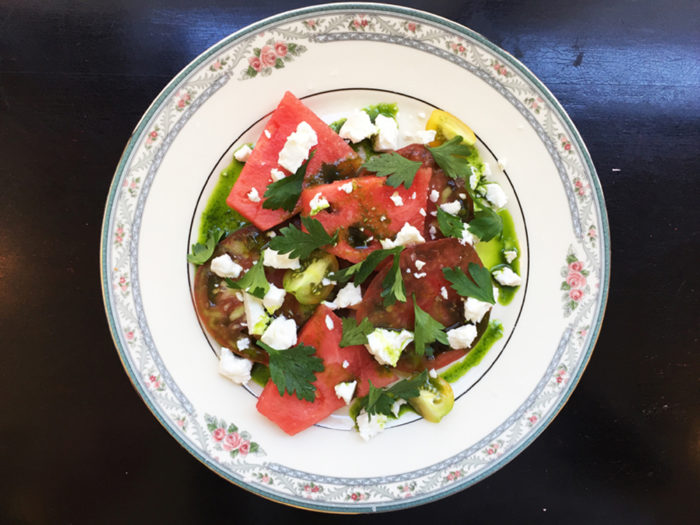
An heirloom tomato salad; Sheila’s hews closely to the farm-to-table ethos (Photo courtesy of Sheila’s)
The Early-morning Grind
“It’s very difficult for me to get up at 4:30 in the morning,” says Clarke, who lives in Ditmas Park. “So it’s an adjustment for me to be ready to serve and operate with quality customer service at 7 in the morning.” But he gets to witness the commuting waves of Brooklynites, and try to understand what everyone wants. Take, for example, the 7:30 a.m. crowd: “They need some speed because they have to get on the train, but–and I’m not saying everyone’s like this–but they want to walk into a nice space that has a good vibe and feel like somehow it’s the way they want to start their day.” They’ve seen locals come in three times a day: coffee, lunch, glass of rosé in the evening. In that way, it’s similar to Gramercy Tavern’s strong bench of regulars who are a necessary element for consistency and success.
Finding a Sounding Board
Clarke likes to run the place with input from his group of creative collaborators, advisers and artists. “It’s not just myself and my wife who make decisions,” he says, “We go to this group and bring them into the fold and ask them what they think.” A background in film makes him especially suited for collaboration—he moved to New York to study performance, directing and acting. He and Molly shot a short feature film (unreleased so far) around Sicily and Canada while Clarke still worked in restaurants and Molly worked in industrial design. Making a film with a team against all odds was appealing, he says. Turns out it pretty closely mirrors going out and starting a restaurant.
Finessing the Edges
Cookie-cutter restaurants crumble quickly in Brooklyn. There is a line between chic and cheesy, and one wrong pendant light can push an establishment over the edge. At Sheila’s, aesthetics matter. They didn’t have much time to get the place up and running, but managed to have the French artist who did Keith McNally’s Pastis and Balthazar paint the walls a soothing turquoise. Tables were distressed, walls were plastered, and rusted metal accents were forged. The result is an Old World, European rustic look that’s still casual.
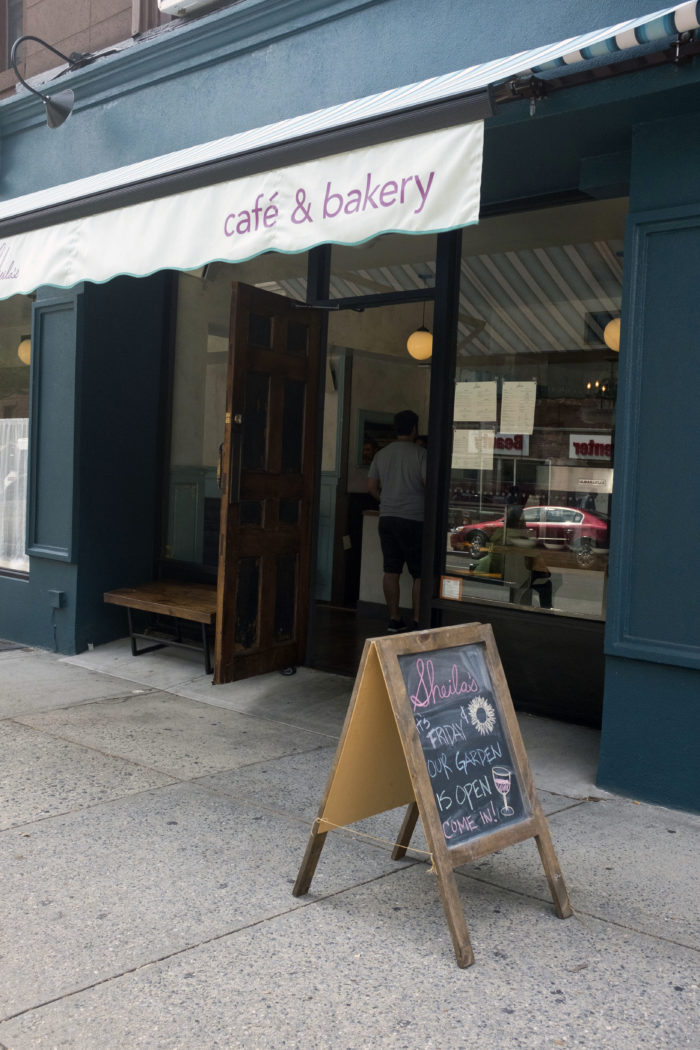
Sheila’s is on Court St. in the space formerly occupied by the restaurant Dover (Photo by Harry Koepp)
Make it Personal
Inspiration for Sheila’s comes from Clarke’s grandmother Sheila, who lived on Bell Island, a small island off Newfoundland in the northeast coast of Canada, where Clarke was raised. “She was hospitality before there was hospitality,” he says. “She was that type of neighborhood person that everybody knew and cared about and she cared about everybody else.” In that sense, he hasn’t only created an homage to a grandmother, but he’s extending her legacy some 1,400 miles away.
Look to the Future
Even among the many plot twists, Clarke’s focused on the big picture. “Whether it’s film or theater or journalism or restaurants, you want to do something of value, and provide something to your guests and provide something to your employees and also prove to yourself,” he says. After the idea phase, “now this whole thing has transitioned from total abstraction to total reality.” What matters now is taking care of the business and the people involved. “There’s no room for ego or dreams,” he says. “Hopefully, in a year, we’ll look back and I’ll vaguely remember the challenges and anxiety and the pain, but we’ll be like, Sales are up!–and we’ll be cruising.”










